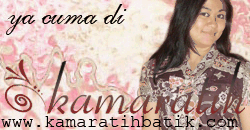Staining technique with prevention techniques coloring cloth using night is one of the ancient art form. This technique has been known since the 4th century BC, in Egypt with the discovery mummy wrapping cloth which is also coated the night to form a pattern.
In Asia, the technique is also applied in China during the T'ang Dynasty (618-907) as well as in India and Japan during the Nara Period (645-794). In Africa, such as the batik technique known by the Yoruba tribe in Nigeria, as well as the Soninke and Wolof tribe in Senegal.
In Indonesia, batik has been around since the time of Majapahit, and became very popular late eighteenth century or early nineteenth century. Batik batik produced until the early twentieth century and the new batik known after World War I or sometime in the 1920s. The word "batik" comes from the Javanese, the presence of batik in Java itself was not recorded.
Batik technique was introduced from India or Sri Lanka in the 6th century or 7th. J.L.A. Brandes (Dutch archaeologist) and F.A. Sutjipto (archaeologist Indonesia) believe that the tradition of batik is a native of the area such as Toraja, Flores, Halmahera and Papua. It should be noted that the region is not an area that is influenced by Hinduism but it is known to have the ancient tradition of making batik.
Gringsing pattern has been known since the 12th century in Kediri, East Java, and this pattern can only be formed by using the canting tool, so that the canting is found in Java in the period surrounding it.
(= G. P. Rouffaer)
Detailed carvings on batik cloth worn by the Prajnaparamita, the statue of Buddhist goddess of wisdom from the East Java the 13th century. Details of this outfit featuring vines pattern and intricate flowers that are similar to traditional Javanese batik pattern as it is today.
This suggests that making intricate batik patterns that can only be made with a canting has been known in Java since the 13th century or even earlier.
Diliteratur Europe, batik technique was first described in the book History of Java (London, 1817) writings of Sir Thomas Stamford Raffles. He had been a British Governor of Java during Napoleon occupied the Netherlands.
In 1873 a merchant of Dutch Van Rijekevorsel give a piece of batik, which is obtained during a visit to Indonesia to Ethnic Museum in Rotterdam and at the beginning of the 19th century, when it began to reach the golden age of batik. When exhibited at the Exposition Universelle in Paris in 1900, Indonesian batik amaze the public and artists.
skip to main |
skip to sidebar
Blog Archive
-
▼
2011
(46)
-
▼
Nov 2011
(13)
- 10 Pasukan Elit Dunia Versi Majalah Time
- Adolescent sexual behavior
- Culture of batik in Indonesia
- Vew of Abortion
- Indonesian Batik from Other Areas
- Children's rights
- Sex Education for Child
- Historical Child labour
- Human trafficking
- History of final girls
- A brief history of BATIK
- Negara-Negara yang Paling 'Gila" untuk Urusan Seks
- Foto Gaul : Bingkai Foto
-
▼
Nov 2011
(13)
Copyright (c) 2012 Masdodon Blog.
Designed by radio-adapter.eu and radioblenden, lenkradadapter, like your blog













No comments:
Post a Comment